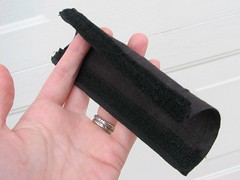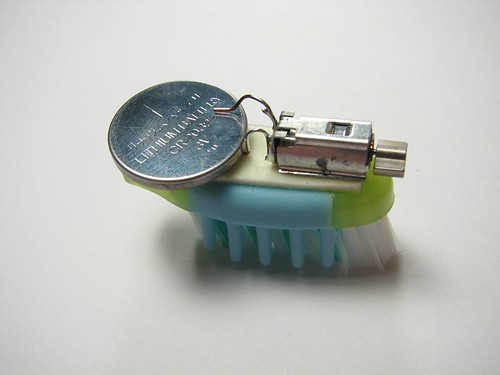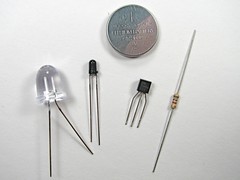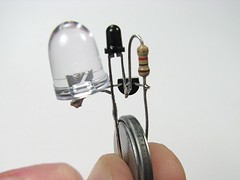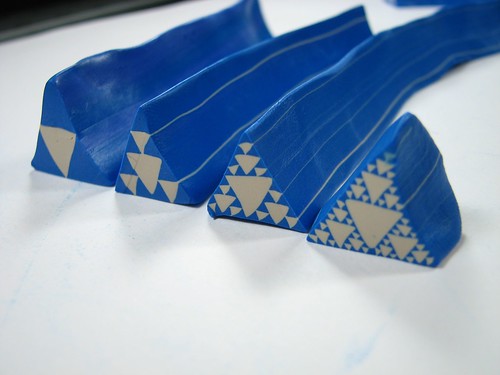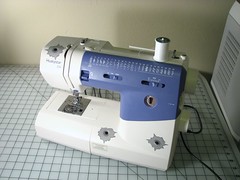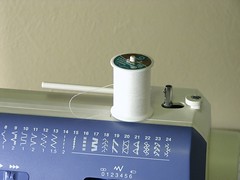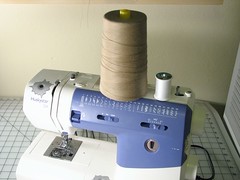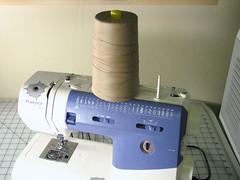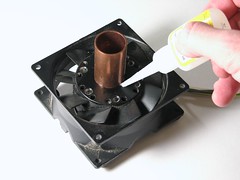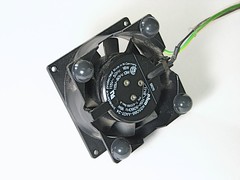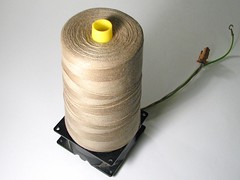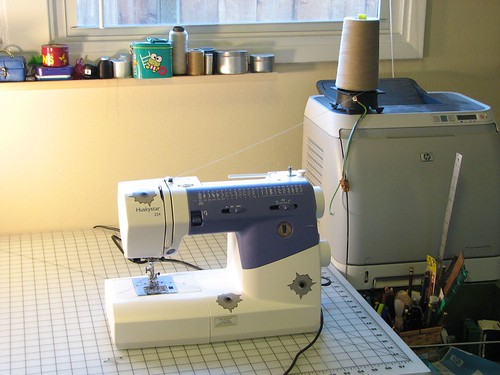This trombone cozy was necessitated by a skin allergy to certain metals. It is a rectangle of soft cotton material with velcro sewn on so that it wraps snugly around the portion of the horn that comes in contact with the trombonist’s neck. I measured the length of the tube we wanted to cover, and wrapped a string around it to get the circumference. I added a bit seam allowance and overlap for the velcro to start with a rectangle of material about 3″ x 7″ and a 6.5″ strip of velcro. I rolled a hem around the four sides and sewed the velcro on. Problem solved– no more neck irritation makes for a much happier band member.
Bristlebot: A tiny directional vibrobot
The BristleBot is a simple and tiny robot with an agenda. The ingredients? One toothbrush, a battery, and a pager motor. The result? Serious fun.
(YouTube video here.)
The BristleBot is our take on the popular vibrobot, a simple category of robot that is controlled by a single vibrating (eccentric) motor. Some neat varieties include the mint-tin version as seen in Make Magazine (check the video), and the kid’s art bot: a vibrobot with pens for feet.
Continue reading Bristlebot: A tiny directional vibrobot
Last minute Evil Mad Shopping and Projects

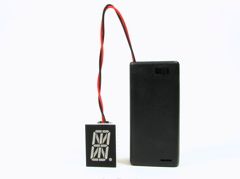
Time to make some LED Micro-Readerboards as ornaments for your tree this year? Watch the short video introduction to see what they do: display a message one character at a time.
This is one of the open-source holiday electronics projects that we released last year. Our up-to-date build instruction are here, including source code. We also have an FAQ about this project, a page of technical data about it, and a discussion forum if you need help with it. The version 2.0 kits (which are still available at the Make Store) use a seriously awesome ultra-high brightness, deep red 16-segment alphanumeric display for long battery life.
As of today, you can also buy the LED displays alone– just the thing for your own custom microcontroller project, alphapov display, name tag, or ornament.
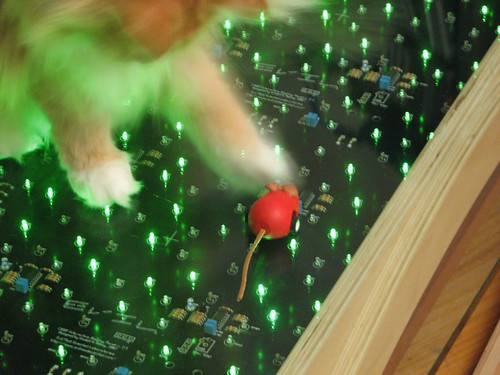
Next, the Interactive LED Panel Kits (as seen in the interactive LED coffee tables that we designed with Because We Can) now come with these beautiful black printed circuit boards. Pictured above, JellyBean combats a mechanical mouse on a table made with a special-order kit that has all green LEDs.
Quite a few of these tables have now been built and there’s even a new instructable from Deadly Computer about the process of building one. During the past month we’ve slowly caught up with the huge waiting list to get a kit, so it’s much easier to get one now. We have even made up some extras of the most popular kit combinations (8 panel with all blue LEDs or blue + white LEDs), which are available in stock to buy right now, shipped to arrive before Christmas to US addresses.

Finally, we have some new multipurpose stickers for sale. Quite possibly the best gift in the world for the software developer in your life.
“These handy stickers will increase the visual appeal of many different items. If you happen to take them to any big box electronics stores, please bring your camera and post pictures in the Evil Mad Science Auxiliary.” We’re waiting for those action shots.
Sorry, we’re open!
We used to live in Austin, Texas, and welcomed the Austin Maker Faire this past October as an excuse to go back and visit. We had a great time at the fair, where our high tech pumpkins (especially the snapping pumpkins) garnered several editor’s choice ribbons.
It was really fun to be back in Austin and remember what we loved so much. One of the things we really miss is the food. I took the picture above of the beautiful neon sign at Magnolia, one of the best of restaurants. Not only do they serve really good food, but they’re open 24/8. The distinct lack of independent 24 hour restaurants in silicon valley is somewhat depressing, but we’re glad to see that the culture is still thriving in Austin, where Magnolia has opened a second branch.
Of course, we inevitably also were reminded of what we don’t love so much. You know how they say that everything is bigger in Texas? Well, it’s true about the bugs.
A Simple and Cheap Dark-Detecting LED Circuit
Here’s a simple problem: “How do you make an LED turn on when it gets dark?” You might call it the “nightlight problem,” but the same sort of question comes up in a lot of familiar situations– emergency lights, street lights, silly computer keyboard backlights, and the list goes on.
Solutions? Lots. The time-honored tradition is to use a circuit with a CdS photoresistor, sometimes called a photocell or LDR, for “light-dependent resistor.” (Circuit Example 1, Example 2.) Photoresistors are reliable and cost about $1 each, but are going away because they contain cadmium, a toxic heavy metal whose use is increasingly regulated. There are many other solutions as well. Look here for some op-amp based photodetector circuits with LED output, and check out some of the tricks used in well-designed solar garden lights, which include gems like using the solar cell itself as the sensor. (Our own solar circuit collection is here.)
In this article we show how to build a very simple– perhaps even the simplest– darkness-activated LED circuit. To our LED and battery we add just three components, which cost less than thirty cents altogether (and much less if you buy in bulk). You can build it in less than five minutes or less (much less with practice).
What can you do with such an inexpensive light-controlled LED circuit? Almost anything really. But, one fun application is to make LED throwies that turn themselves off in the daytime to save power. Throwies normally can last up to two weeks. Adding a light-level switch like this can significantly extend their lifetime.
Continue reading A Simple and Cheap Dark-Detecting LED Circuit
December Quickie Linkdump
Holiday gifts, some math fun, and the usual weirdness.
- We personally endorse the excellent Geek Jewelry from Nicholas and Felice. Here is a bit about the making of.
- Acorn Studios products: Even more geek jewelry
- Don’t count sheep in this chair.
- What’s special about that number
- Virtual Slide Rule. Score!
- Pizza: the final frontier
- Kitties are great. This one likes to play in the water.
- Making fractions easier: Tips that sometimes work.
- LED Hanukkah Menorahs for sale by Lyle.
- God Hates Shrimp (or so I’m told).
- FSM Holiday e-Card Machine
Galaga Quilt by Carolina Patchworks

This Galaga quilt from Carolina Patchworks would make the perfect present for the retro arcade game fan. According to the etsy listing, it “is fully compatible with the XBox 360, Wii, PlayStation III, all high-definition televisions, most models of fireplace, and a wide variety of good books.”
However, only one lucky geek in the world is going to get this seriously underpriced masterwork as their Christmas present this year, so make sure your trigger-finger skills are in tip-top shape before you head on over to etsy.
Thanks, Sean!
Related: QuiltBert
Iterative Algorithmic Plastic Sculpture: Fimo Fractals
One of our favorite shapes is the Sierpinski triangle. In one sense, a mere mathematical abstraction, on the other, a pattern that naturally emerges in real life from several different simple algorithms. On paper, one can play the Chaos Game to generate the shape (or cheat and just use the java applet).
You can also generate a Sierpinski triangle in what is perhaps a more obvious way: by exploiting its fractal self-similarity.
Continue reading Iterative Algorithmic Plastic Sculpture: Fimo Fractals
Cars with Chrome
Although I do love my Prius, at heart I’m a fan of old cars. Real cars, not the indistinguishable bubbles they make now. I’m not an expert, and I haven’t even learned to drive a stick (yet– that day will come). But I do know what I like, and as far as I’m concerned, the more chrome, the better. Bold grilles. Bright flashy emblems. Lots of curves. Really curvy curves. And hood ornaments. Very elaborate hood ornaments.
After going to a neighborhood holiday parade (with lots of cars!) I realized that my photo collection is getting ridiculously large, so I finally put my pretty car pictures all in one spot. You can check them out in this flickr set. Don’t worry, I’ll still keep the art cars in their own set.
For more vintage car fun, my favorite places to look are the Hemmings blog and its associated flickr group, Hemmings Nation; Telstar’s car photos on flickr; and the Chrome, Smoke and Fire flickr group which has, among others, Coop’s car photos. And Coop really knows how to look at a car. He knows how to look at girls, too, so use caution before clicking over to his photostream (definitely NSFW). I know there’s a group for every possible car specialization out there, which makes me all the more glad for sites like Hemmings and Chrome, Smoke & Fire that are more general and inclusive for folks like me who enjoy whatever shiny things come their way.
5-minute project: Spool spinner from an old fan
One of the common features on small “straight-stitch” sewing machines is a little rod on the top, called a spool pin. The spool pin holds a spool of thread and allows it to turn freely and feed out thread while the machine operates.
Seems straightforward enough, right? But what if you want to start working with larger spools of thread? Here’s an example that we brought home recently that, on first blush, just doesn’t look like it will work:
By comparison, the standard spool of thread looks puny, and the spool pin looks even punier. Even if this large spool were able to fit onto our tiny spool pin, it could not spin freely because of its weight and friction.
So how can we use the spool? Our solution was to design a larger, heavy-duty “spool spinner,” incorporating low-friction precision ball bearings. Total budget: $0.00– using stuff from the junk bin only– and under five minutes.
Parts used: an old “box” or “muffin” fan (the older and heavier the better), some rubber feet, a little piece of copper pipe, and superglue.
The fan that we found is an old 120 V AC type, made of cast aluminum and very sturdy. It doesn’t matter if it is electrically good; all that matters is that it spins well. To the spinning part of the fan we added a short copper pipe as our center pin, which turned out to be about the right size for the center of this particular spool. We used superglue to hold the copper piece in place. (Note: waiting for the glue to cure is the slow part of this build.)
Add rubber feet to the other side of the fan and it’s ready to go.
Rather than keeping ours on top of the sewing machine we put it on the printer next to the sewing table, where it is less likely to get knocked over. (Side note: The cat enjoyed this setup.)
In practice, the fan bearing turns freely enough that the sewing machine can spin the spool as needed, but not so freely that it starts to turn and then unwinds the whole spool, so it works quite well.
Obviously this is a quick hack and is not the only approach to the problem– there’s nothing so fancy as a ball-bearing spool spinner on an industrial sewing machine, even though it can use huge spools. Instead, the spool is held in place while the thread is pulled off axially through a well-defined aperture. (Spools like this one, as you can tell from the slight conical taper, are actually designed to be used that way.) An advantage of our “spinner” design is that it works equally well with many different kinds of spools. It could even be a useful tool when winding coils from spools of wire.





